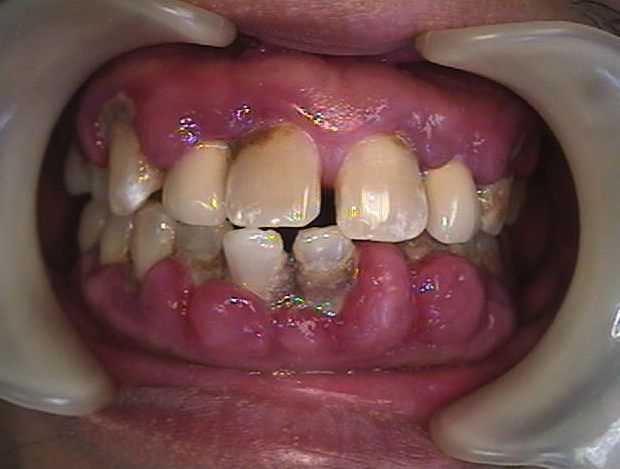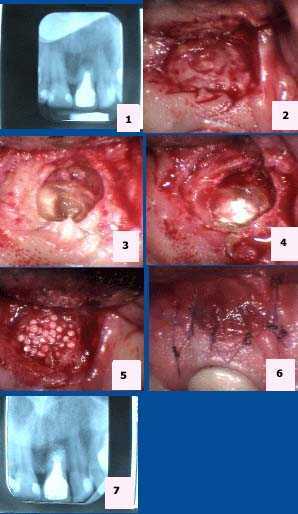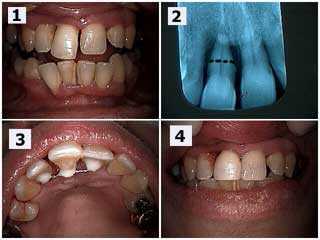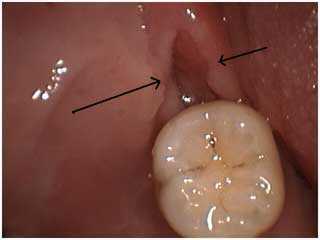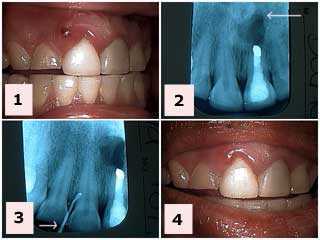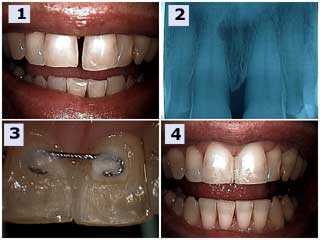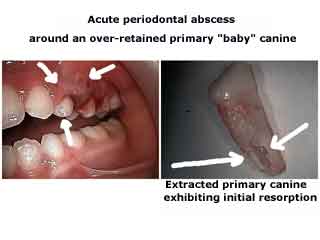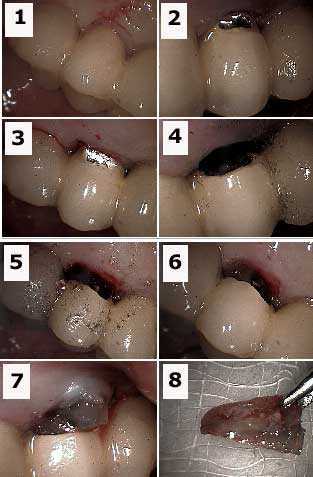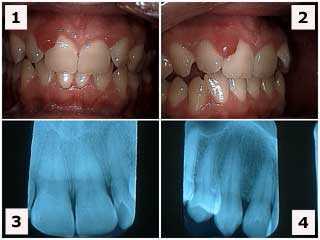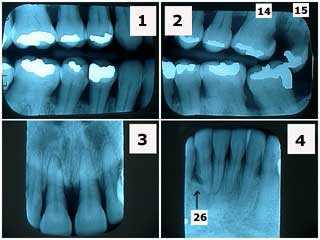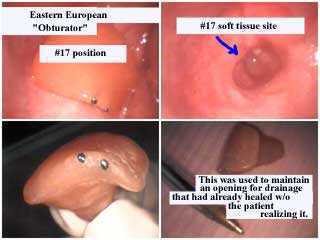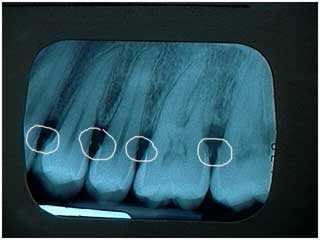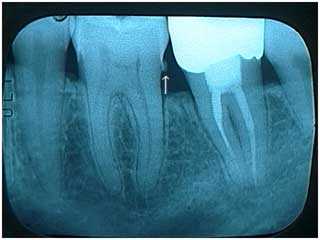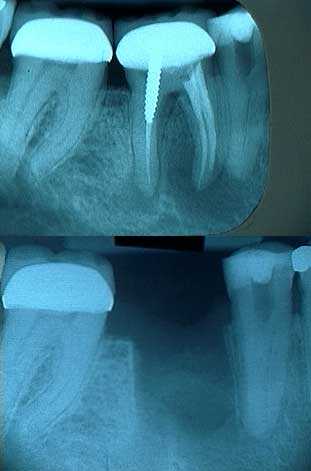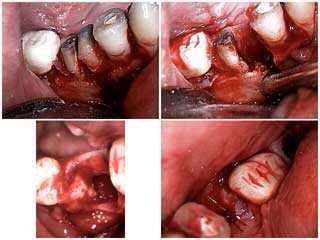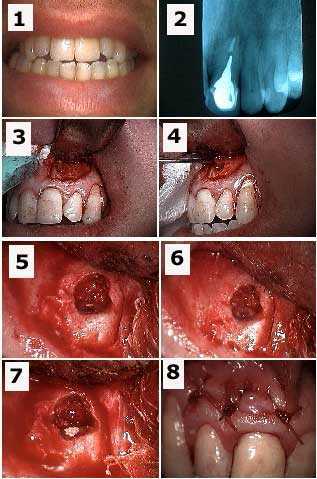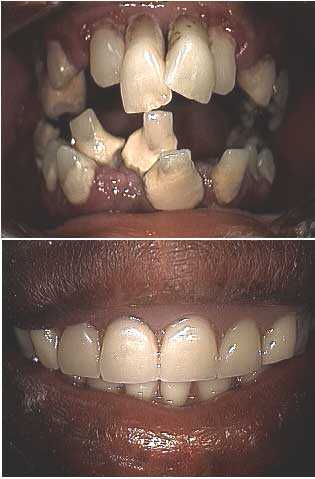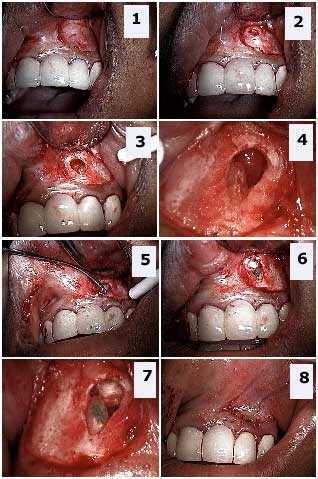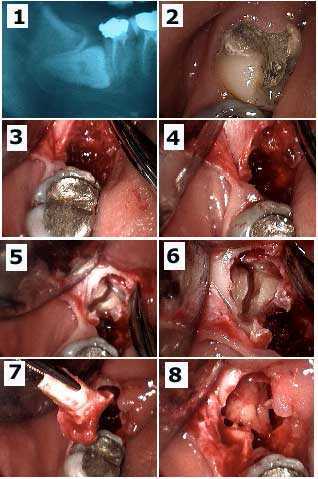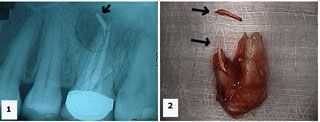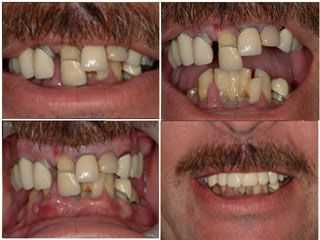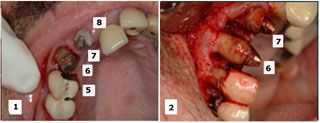Periodontics treats bad breath and bleeding gums. Gum disease treatment intends to eliminate the bacterial infection that also causes a bad taste in the mouth. This is frequently also associated with swollen gums. Our gum disease treatment team includes 16 cosmetic dentists, specialists (including a Periodontist) and lab ceramists in one high-end midtown Manhattan office. Our staff Periodontist provides conservative gum treatment and utilizes periodontal gum surgery only as a last resort.
As a result we are able to offer quick and comfortable non-surgical gum care. We offer intelligent and honest diagnosis based upon 31+ years of experience. We use the finest materials and top labs. Along with our dental hygienists we teach our patients the many choices they may have regarding the nature of their specific type of gum disease, various preventative measures they may employ at home and the benefits & risks of each type of proposed periodontal therapy. Visit us for the finest gum disease treatment.
Before and after photos on infected tooth causes pain abscess and swelling performed in our Gum Disease Treatment office.
Periodontal gum infection causing whole mouth oral tooth pain caused by using Calcium Channel blockers without advance maintenance of the gums. Calcium Channel blockers are commonly used to treat high blood pressure, angina pectoris and coronary artery disease. Physicians should obtain periodontal clearance before prescribing such medication.
Root canal infection causing tooth pain. Apicoectomy treatment of tooth #9. 1) Xray. 2) The Oral Surgeon isolated the apical area. 3) Exposure of the root apex. 4) Placement of mineral trioxide aggregate. 5) Placement of hard tissue bone replacement. 6) 6-0 Vicryl sutures. 7) Post op xray.
Gum infection and localized mouth pain associated with an abscess from an upper front tooth. The upper right front tooth was mobile and the patient wanted to try to save it. 1) This tooth has grown down out of the gum and also moved toward the lip creating a tooth gap space. 2) This x-ray shows severe bone loss. The black dotted line shows the location for a potential root resection if necessary. Root planing was performed after the teeth splint was placed and the patient will revisit the Periodontist in three months to reevaluate healing and the potential need for the root resection. 3) Palatal photo of the splint between teeth #’s 7 – 9. 4) Post-op view. The tooth gap space was closed with dental bonding to hide the splint and the excessive length of #8 was reduced. Treatment time – one visit.
Treatment of a periodontal gum infection abscess and tooth pain due to hyperplastic pericorium. A distal wedge gum surgery was performed one week earlier. This periodontal surgery is performed to remove the pericorium that may grow over the biting surface of the lower back molar. The pericorium in this patient had occasionally become infected and very painful and required antibiotics.
Acute periodontal gum abscess that caused mouth pain. 1) This patient presented with a gum infection and fistula between her central and lateral teeth. The two central teeth had acrylic veneers placed about two years ago. Her general dentist had performed a gingivectomy last year to attempt to treat the occasional swelling of the gum in this same area. 2) X-ray of tooth #9 shows a healed apicoectomy from 12 years ago that is not related to the current problem. 3) A gutta percha point was placed in the draining fistula – a gum boil – and radiographed to see where it lead. It stayed at the veneer margin. The patient was put on tetracycline for a week. [This is not a treatment recommendation for everybody!] 4) Reevaluation two days later show improvement in symptoms and gingival gum inflammation. An evaluation and treatment of the veneer margin will occur following resolution of the acute condition. Photo 1 of 2.
Tooth infection and tooth pain associated with a gum abscess. Before and after pictures – controlling the emergency oral pain – two days later. More dentistry is needed in this area. A Periodontist evaluation and treatment of the veneer margin contour will occur following further resolution of the acute condition. Photo 2 of 2.
Treatment of a tooth gum infection around a maxillary left central incisor #9. 1) & 2) Before photo and x-ray. The angular bony defect in the xray is the site of the infected gum. The patient said that the tooth was getting longer and that he never previously had the tooth gap space between his two front teeth. 3) Palatal photo of the splint placed between teeth #’s 8 & 9. 4) The after photo one hour later. Dental bonding placed between the front teeth to close the space also hide the palatal splint. The incisal edge of the longer central incisor was shortened and the occlusion was checked and adjusted for fremitus. Periodontal scaling was performed next and the patient was placed on a three month Periodontist reevaluation.
Treatment for emergency tooth pain gum abscess around an over-retained primary baby canine. The extracted primary canine is shown in the second photo.
How to perform a root resection from under a porcelain fused to metal dental bridge. This periodontal tooth infection caused gum pain and an intra oral abscess. 1) Labial photo of an abutment with an endodontic periodontal infection. 2) & 3) Initial preparation into porcelain with a diamond bur. 4) Labial photo shows preparation. The metal portion of the teeth bridge is prepared with a steel bur. 5) Palatal photo shows preparation. 6) Labial photo show the tooth root under the porcelain bridge (gutta percha is visible in the tooth root). 7) The tooth root is being extracted. The occlusal height of this root must first be reduced to allow it to exit. 8) The extracted tooth root.
Acute periodontal abscess that did not cause tooth pain. This patient had not been to the dentist for over two years. The x-rays look normal. He received a dental cleaning and was placed on a chlorhexidene mouthwash. He was rescheduled for scaling and root planing and then reevaluation with the Periodontist.
These x-rays show general gum infection, tooth infection around teeth #14 & 15, and a gum abscess around tooth #25 in a patient who did not feel dental pain. This is severe periodontal gum disease in a 40-year-old female who suffered from dental fear anxiety. Note the significant horizontal bone loss and the lack of radiographic calculus. Tooth #26, adjacent to the vertical bony defect, is probably hopeless. This patient was treated with two rounds of scaling and root planing and then reevaluation with the Periodontist. A tooth extraction was performed on #15 and #14 had root canal therapy and a dental crown.
An Eastern European dentist made this prosthesis to permanently maintain drainage for a gum infection fistula in #17 position. The tooth extraction for #17 had occurred long ago and it appeared to have healed except for the space created by this obturator. It no longer appeared to be necessary but was certainly interesting to see.
Teeth infection: Radiographic x-ray calculus – calcified dental plaque. Calculus is plaque that becomes hardened by absorbing salivary calcium and then becomes evident on x-rays. It usually means there is a gum infection that can occur without teeth pain. A dental prophylaxis teeth cleaning, and then possibly scaling and root planing is usually indicated, followed by periodontal reevaluation by a Periodontist. The patient may have noticed symptoms that could include swollen gums or gum bleeding. Tooth pain may not occur until very late stages of gum disease.
Oral Mouth Infection – dental plaque. Radiographic xray calculus is dental plaque that becomes hardened by absorbing salivary calcium and then becomes evident on x-rays. It usually shows the long term presence of teeth plaque and is a predictor of a gum mouth infection that can lead to a tooth abscess on one or more teeth or a full mouth oral infection if left untreated. A dental prophylaxis teeth cleaning is usually performed by a dental hygienist who may then also follow up next with full mouth scaling and root planing. An evaluation by a Periodontist may also occur.
Radiographs of severe periapical pathology radiolucency around the mesial and distal roots of tooth #30 leading to tooth extraction. This periapical root canal infection developed into a gum abscess or gum fistula. The gum around the tooth was swollen and the patient had a lot of gum pain.
Tooth extraction of a mandibular molar due to severe periapical pathology – endodontic root canal infection. 1) The xray shows severe periapical pathology – tooth infection – around both the mesial and distal tooth roots. 2) This photo shows buccal fenestration around the mesial root following a vertical surgical incision and a periodontal flap. 3) The extracted mesial tooth root with the noted pathology – the tooth abscess – attached. 4) Post-op photo of the tooth extraction site.
Extraction of an infected tooth due to a combined gum infection and swollen tooth abscess. How to pictures. Photo 1) Sectioning – cutting – of the mesial and distal tooth roots. Photo 2) Removal of the mesial tooth root. Photos 3) & 4) Photos of the tooth extraction site.
An apicoectomy is a root canal oral surgery performed when tooth infection persists after completing endodontic root canal therapy and access through the original route is not advised. Tooth pain or a draining gum fistula boil are common symptoms. The tooth typically will not hurt when the gum abscess is draining through the fistula.
These pictures show how to perform an apicoectomy and a retrograde filling on an upper front tooth #9. 1) Pre-op photo. 2) X-ray of tooth #9 with a cast post and root canal filled with gutta percha to the apex. 3) Initial semi-lunar surgical incision exposes the bony fenestration. 4) The tooth cyst is being pulled through the osteotomy with a forceps by the Oral Surgeon. 5) Osseous preparation exposes the tooth apex with the gutta percha visible. 6) This photo shows preparation into the root apex to make room for the retrograde filling. 7) Retrograde filling material (MTA, Mineral Trioxide Aggregate) placed into the tooth root apex preparation. 8) Sutures.
How to treatment for infection tooth pain abscess under a dental bridge. Pictures: Root resection from under a porcelain fused to metal ten teeth bridge. 1) X-ray showing the distal tooth abutment with an endo-perio lesion – a root canal gum infection. 2) Labial photo of the same tooth. 3) Radiograph following the tooth root resection (the metal tag in the area of the extracted abutment was later removed). 4) Labial image following tooth root extraction. This area could be filled in with dental bonding after healing. The occlusion – teeth bite – on the distal cantilever was reduced. It opposed a lower full arch bridge so that supra-eruption was not a concern. Treatment options include: i) sectioning and removal of the distal cantilever, ii) dental implants, or iii) reevaluate over time with the patient informed to reduce function in this area.
Oral infection mouth pain teeth abscess with infected gums and an unhealthy occlusion – dental bite. This full mouth oral reconstruction dental phobia fear patient had it all. During this initial visit it was important to determine what teeth, if any, may be saved at least temporarily because it is easier for a patient to emotionally adjust to a provisional temporary non- removable dental bridge that has at least some amount of retention provided by natural teeth abutments. Emotional support and consideration of the dental anxiety is half the battle in getting this patient what she needs.
Treatment of periodontal gum teeth abscess with oral mouth pain in a full mouth rehabilitation patient who suffered from dental phobia fear. This patient had been afraid scared of the dentist since childhood. Before and after pictures.
Apicoectomy and retrograde filling for the treatment of infection tooth pain abscess and draining fistula in a upper front tooth. How to photos: 1) Upper left lateral incisor shown with gum tissue reflected. 2) Initial penetration through cortical bone. 3) Tooth apex located. 4) Tooth root after sectioning – cutting – off the apex. 5) Application of Mineral Trioxide Aggregate (MTA) retrograde filling material. 6) – 7) MTA in place. 8) Closure of the oral surgery site.
Locating the source of a draining fistula tooth infection abscess with the use of gutta percha and a post-op x-ray of the subsequent apicoectomy – root canal oral surgery treatment. Gutta percha can be gently placed into a draining fistula without anesthesia – novocaine.
Tooth extraction of a horizontally-impacted mandibular lower wisdom tooth and a second molar with very big tooth decay cavity in an area of gums infection pain. The patient had a lot of tooth pain. 1) Pre-op x-ray. 2) Tooth #31 had a temporary dental filling in it. 3) – 4) After removal of the dental crown of #32 showing the residual empty tooth socket. 5) – 6) Minimal gum surgery flap reflected to show exposure of the tooth roots of #32 with sectioning. 7) Extracting – removal of first root. 8) Second root brought forward in socket and ready for removal. How to pictures.
Tooth pain infection abscess in a hopeless maxillary molar tooth. 1) Xray shows an upper first molar tooth with gutta percha – root canal filling material – extruded into a large radiolucent area – the area of the oral infection in the jaw bone. 2) Palatal picture of the extracted tooth shows the extent of the gutta percha extrusion. The extra fragment shown is also gutta percha.
Full mouth oral infection pain disease of the gums with complete loss of occlusion – dental bite – in another dental anxiety fear patient. This reconstruction first involved controlling the dental fear of the dentist. The lower right photo shows the initial post op result.
How to treatment: Teeth periodontal disease gum infection and selective tooth extraction during the initial gum surgery for a maxillary oral reconstruction. The initial treatment plan considered saving teeth #’s 6, 7 and 9 while extracting #’s 5 and 8. During the periodontal gum surgery, #5 was considered more stable than #6 so #5 was retained and #6 was extracted. The retained teeth will be used to support a fixed temporary dental bridge until subsequent implant dentistry is completed.
